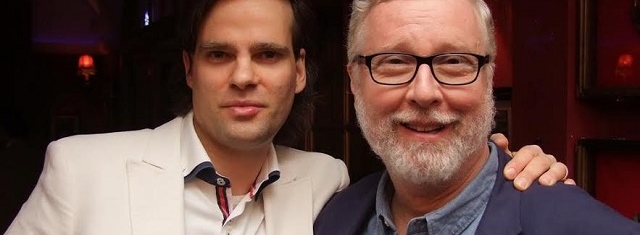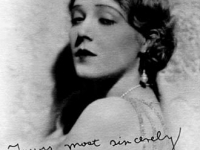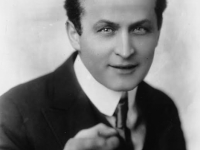Entertainment
The two best of s memories are still alive
Vilma Banky and Harry Houdini

USPA NEWS -
Vilma Banky, the best silent film actress and Harry Houdini, the best magician and escape artist the world has ever known.
The Hungarian Hollywood Council very actively keeps the memories of Hungarian-born Hollywood stars alive.
The Hungarian Hollywood Council very actively keeps the memories of Hungarian-born Hollywood stars alive.
The Council and its founding father, Ambassador Balazs Bokor, former Consul General of Hungary in Los Angeles is fully convinced that the life and success of those important stars should be remembered not only at a certain birthday or death anniversary, but in our everyday life, too.
A “best of“ silent movie was Vilma Bánky, a Hungarian-born silent film actress. Banky was best known for her roles in The Eagle and The Son of the Sheik with Rudolph Valentino and several romantic teamings with Ronald Colman.
A “best of“ silent movie was Vilma Bánky, a Hungarian-born silent film actress. Banky was best known for her roles in The Eagle and The Son of the Sheik with Rudolph Valentino and several romantic teamings with Ronald Colman.
The Hungarian Hollywood Council organized a memorial evening of Vilma Banky in the fashionable Stefania Palace in Budapest. Banky`s first film appearance was in the now lost film, In the last moment, directed by Carl Boese in Germany in 1919. On a trip to Budapest in 1925, Hollywood film producer Samuel Goldwyn discovered and signed her to a contract. Both her mother and father were vehemently against Bánky´s acting career as was her fiancé; nonetheless she left for the United States in March 1925, arriving to a great deal of fanfare.
She was hailed as “The Hungarian Rhapsody“ and was an immediate hit with American audiences. The New York Times remarked in its review of her first American film, The Dark Angel, that she “is a young person of rare beauty “¦ so exquisite that one is not in the least surprised that she is never forgotten by Hillary Trent“ (the movie´s leading male character who decides to allow his family and fiancee to believe him dead rather than place what he perceives as the burden on them of a life caring for a blinded war veteran).
She appeared opposite silent great Rudolph Valentino in The Eagle (1925) and The Son of the Sheik (1926) It is said that Valentino was fascinated by Vilma, and it was he who chose her as the first lady in the films and Ronald Colman in a series of love stories, including The Dark Angel and The Winning of Barbara Worth. Of her twenty-four films, eight exist in their entirety. She married actor Rod La Rocque in 1927; they remained married until his death in 1969. They had no children.
Vilma Bánky died on March 18, 1991, from cardiopulmonary failure, aged 90. For her contribution to the motion picture industry, Vilma Bánky has a star on the Hollywood Walk of Fame located at 7021 Hollywood Blvd. The audience at the Budapest Stefania Palace cheered the success of Vilma Banky. Hungarians are proud of their Hollywood actress.The House of Houdini is a museum and performance venue located at 11, Dísz square in the Buda Castle in Budapest, Hungary. It claims to house the largest collection of original Houdini artifacts in Europe. The House was established by David Merlini, also a Hungarian, an escape artist who represents the pure essence of the art of escapology in the 21st century.
The Hungarian Hollywood Council`s President invited some selected V.I.Ps into the House of Houdini on the night of March 24, the birthday of Harry Houdini. Houdini`s grand illusions and daring, spectacular escape acts made him the most famous magician of all time. Born Erich Weisz on March 24, 1874, in Budapest, Hungary, young Harry Houdini moved with his family to Appleton, Wisconsin, where he later claimed he was born. Fascinated with magic, he began performing and drew attention for his daring feats of escape. In 1893, he married Wilhelmina Rahner, who became his onstage partner as well. Houdini continued performing escape acts until his death, on October 31, 1926, in Detroit, Michigan.
Houdini continued his act in the United States in the early 1900s, constantly upping the ante from handcuffs and straightjackets to locked, water-filled tanks and nailed packing crates. He was able to escape because of both his uncanny strength and his equally uncanny ability to pick locks. In 1912, his act reached its pinnacle, the Chinese Water Torture Cell, which would be the hallmark of his career. In it, Houdini was suspended by his feet and lowered upside-down in a locked glass cabinet filled with water, requiring him to hold his breath for more than three minutes to escape. The performance was so daring and such a crowd-pleaser that it remained in his act until his death in 1926.
As president of the Society of American Magicians, Harry Houdini was a vigorous campaigner against fraudulent psychic mediums. Most notably, he debunked renowned medium Mina Crandon, better known as Margery. This act turned him against former friend Sir Arthur Conan Doyle, who believed deeply in spiritualism and Margery's sight. Despite his activism against spiritual charlatanism, Houdini and his wife did in fact experiment with otherworldly spiritualism when they decided that the first of them to die would try to communicate from beyond the grave with the survivor. Before her 1943 death, Bess Houdini declared the experiment a failure.
Though there are mixed reports as to the cause of Harry Houdini's death, it is certain that he suffered from acute appendicitis. Whether his demise was caused by a McGill University student who was testing his will by punching him in the stomach (with permission) or by poison from a band of angry Spiritualists is unknown. What is known is that he died of peritonitis from a ruptured appendix on October 31, 1926, at the age of 52, in Detroit, Michigan.
So, two great Hungarian-born personalities, both having a bright star at the Walk of Fame in Hollywood, were respectfully remembered far away from their place of death. However, they should have been happy if they were aware of how Hungarians and in their avantgarde, the Hungarian Hollywood Council reminded the world about their brilliant art just at their birthplace“¦
Liability for this article lies with the author, who also holds the copyright. Editorial content from USPA may be quoted on other websites as long as the quote comprises no more than 5% of the entire text, is marked as such and the source is named (via hyperlink).








